A lot has been written about landscaping. I do not want to repeat myself, because I will describe the main points here and focus on the problems that I directly encounter when shooting.
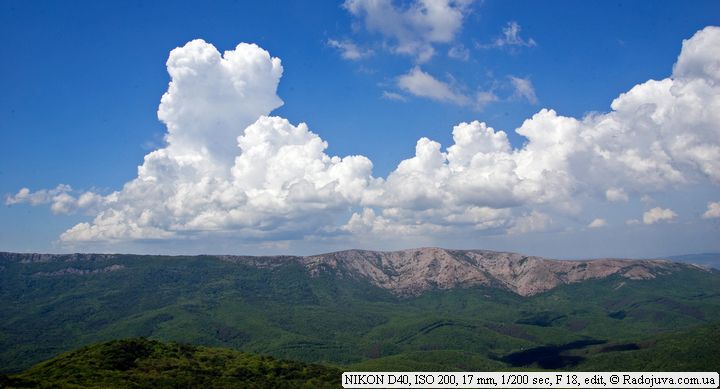
Landscape photo
A very brief guide to photographing landscapes:
- Watch the diaphragm, often, you need to close it tightly to F / 5.6-F / 16.0
- Keep track of the horizon, the horizon should harmoniously “cut” the frame. Carefully and thoughtfully compose lines and proportions in the frame
- Watch out for light sources (the sun)
- Enjoy the result
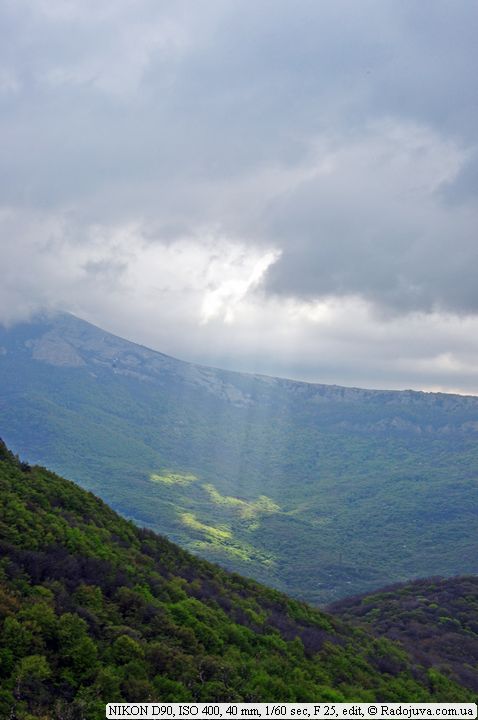
Landscape photo
As you can see, there is nothing complicated in shooting the landscape. But the problem is to get a high-quality picture, you need to work hard:
- Landscape implies that you will need to find it. Finding a pretty landscape is not always easy. Very often, when you find a good landscape, there is no camera with you.
- It is best to shoot in the morning and evening, when there is no “hard” (strong) sun. Shooting in strong and hot sunlight is very difficult.
- Since it is best to shoot in the morning and evening, and even with closed apertures, you need a tripod. A tripod means extra expenses and extra weight during transportation.
- To catch good shots, you need an internal sense of harmony, which can either be innate or acquired over a long time photographing.
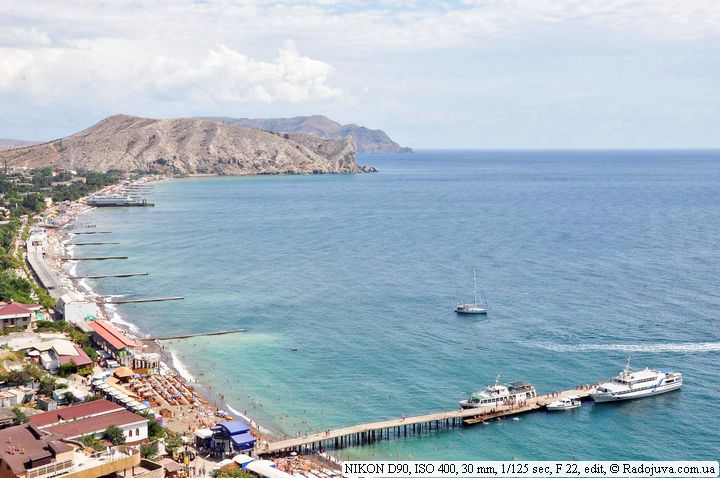
Landscape photo
Masters of landscape photography have in their arsenal a very large stock of skills and best practices, it is useless to describe them, since every little thing in cunning will be useful only in one out of a hundred cases, and the person himself must choose how he needs to be removed in a particular situation.
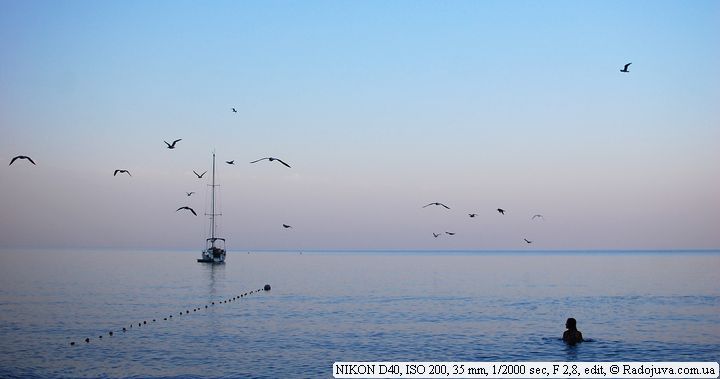
Landscape. The horizon line divides the photo off-center. The sky takes two-thirds of the picture.
Setting up the camera for landscape photography
- Almost always, the landscape is shot on a closed aperture: F5.6-F36.0. The easiest way to do this is in aperture priority mode.
- The ISO value must be set to the minimum: ISO 50, 100, 200, lo1
- Color Saturation Adjustment - Maximum
- Focusing is best of all - manual, focusing preferably at infinity (on the farthest object)
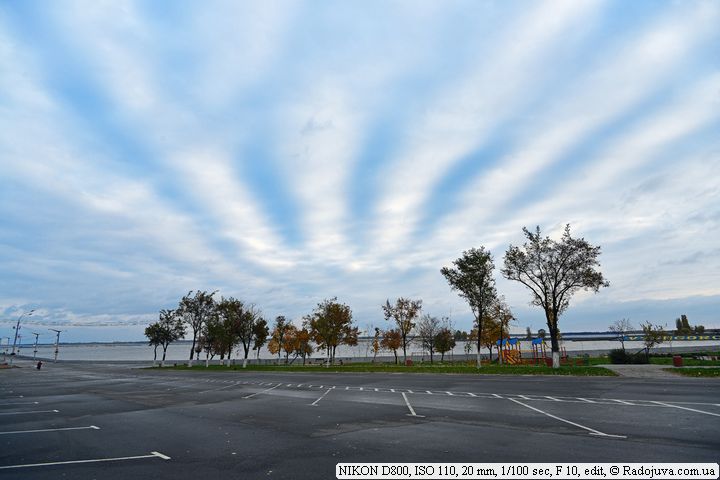
Landscape photo
Theory is great, but with practical shooting, all the simplicity vanishes. First, when shooting landscapes, a very serious problem is the effect of overexposure or overexposure of areas in the photo... The most common example is a photo of black earth and white sky. In this case: either the sky will be with details, and the earth will be completely black (dark, without details), or the earth will be normally exposed, but the sky will be strongly lightened (overexposed). This is due to the dynamic range of the camera. A gradient filter helps to solve this problem, which compensates for the difference in the “glow” of the earth and sky. Very often, it is enough to make an amendment exposure in order to "save" the frame a little. For a landscape, it can be very useful polarizing filter.

Landscapes are easy to shoot not on the phone due to the fact that on many phones the lens has a focus on hyperfocal distance
Second: landscapes are shot on closed (covered) apertures... On digital-SLR cameras with closed apertures, every speck of dust on the matrix will be visible. This is very unnerving, frustrating and ruining the photo. For example, already on F11 "blots" appear on the matrix (they can be seen in the examples for this article). On the F14, fine dust is already quite visible. You can fight this ailment with the help matrix cleaning, or by lowering the aperture value. It's funny, but ordinary digital cameras (soap dishes) and film cameras are less prone to this ailment. But, soap dishes suffer greatly from diffraction by closed diaphragms.
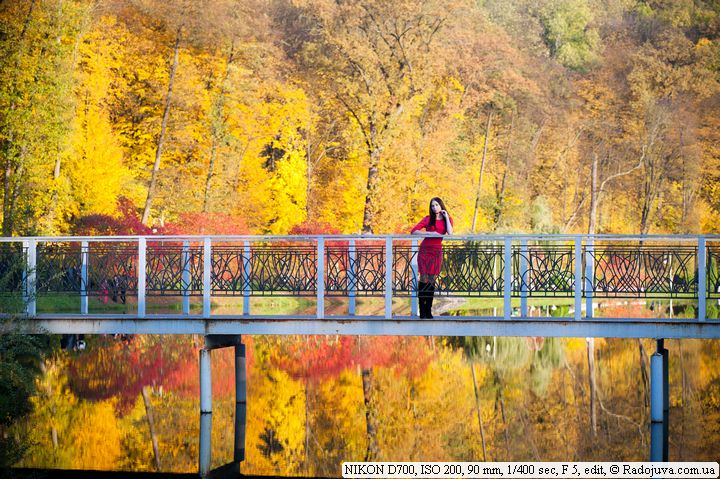
Landscape photo
Thirdly: often, by eye it is very it’s difficult to compose a frame, so that the lines fit perfectly into the frame. The horizon line strives to bend. When I shoot hand-held, thoughtfully and attentively, and then look at the footage on the computer, the horizon often "falls" by a couple of degrees. For some plots, even 5 degrees is already an unacceptable error. To overcome the littered horizon, I turn on the "grid" in the viewfinder. The grid draws lines, dividing the frame into 9 or 12 segments, which allows you to immediately see the symmetry in the frame, as well as position the horizon evenly. Almost all Nikon CZKs support the grid. Some cameras have a virtual horizon (for example, D300s), which allows you to control the line. Well, if there are problems with lines at all, then you can crop the image with rotation of the plot in Adobe Photoshop or other editors.
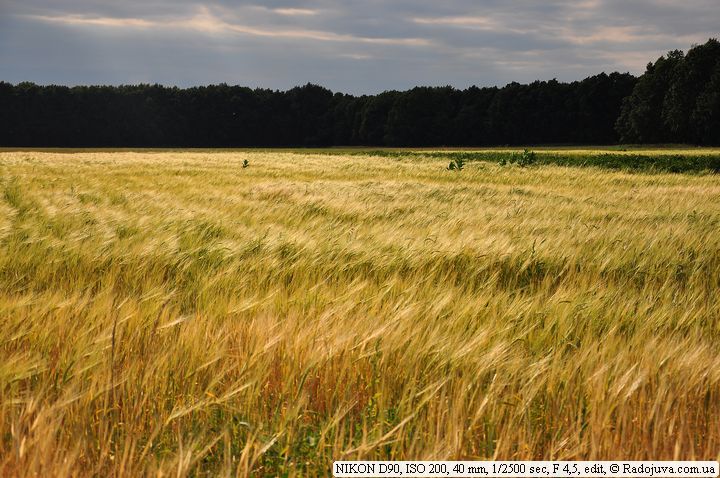
Field. Landscape.
Fourth: for landscapes, most often, need a very wide viewing angle, for this use wide-angle and super wide angle lenses... All “super-widths” have distortion (geometry curvature). Distortion can spoil the picture very much, or it can make it unusual (like, for example, the fish-eye effect). However, the less distortion, the better. Unfortunately, all ultra-wide-angle lenses have this disadvantage. Distortion can be corrected using graphic editors, some cameras have built-in distortion correction for a number of lenses (for example, Nikon D5100) Or, you can shoot with a longer telephoto lens without distortion. Photos of the sky taken at fifty dollars Nikon 50mm F1.8D AF, this lens does not have distortion.
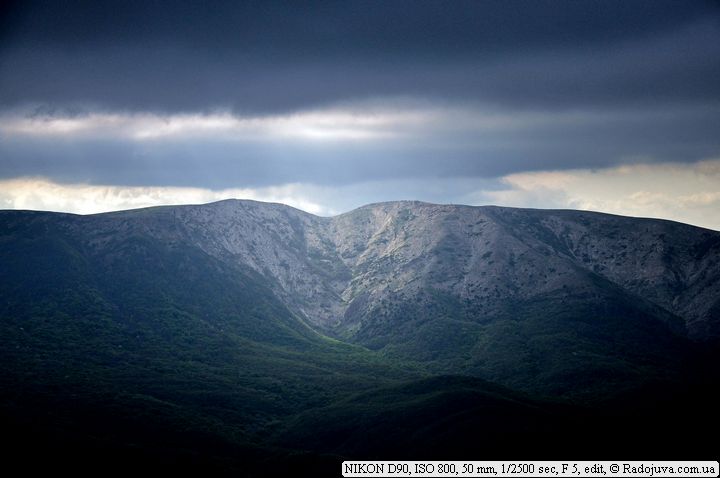
The mountains. Landscape.
Personal experience:
If I shoot without a tripod, I use S mode (priority excerpts) I usually set the value from 1/80 to 1/200, while I know that the aperture will be very closed when shooting (in good light), which is necessary for the landscape. In poor lighting conditions, I’ll still get a fairly sharp shot without blur, taking it off hand. When I use a tripod, I work in A or M mode (aperture priority or manual mode). With a tripod, long excerpts on closed diaphragms. I rarely shoot landscapes, because this is where my experience ends.
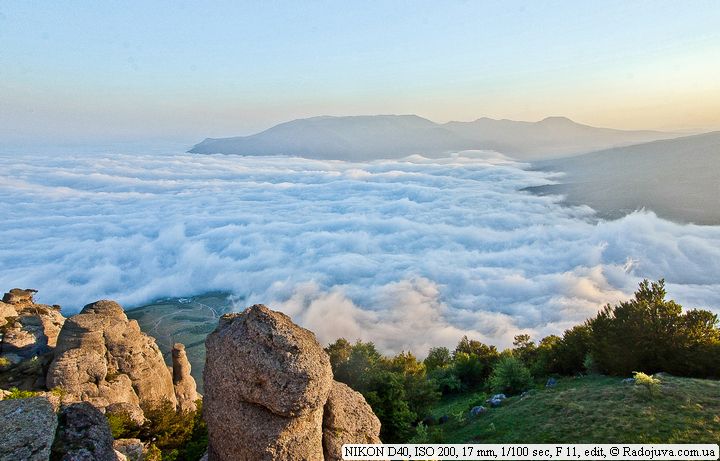
Fog in the mountains
I am often asked, but what is the best aperture for landscape? There is no single answer. Sometimes, to shoot handheld in the evening, F2.8, ISO 800 is enough. And sometimes, to “freeze” the waterfall, you need F / 36.0 ISO 100. By the way, at closed apertures, almost all lenses (and whale ones) give a very sharp image, so that, chasing a specialized landscape lens for home purposes - it makes no sense.
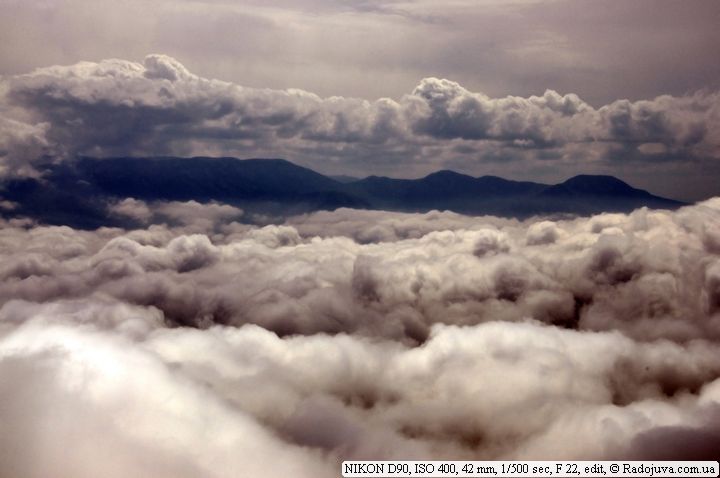
The clouds.
Landscape photography is very complicated if you need to shoot a person against the background of nature. In this case, focusing on infinity will not always help. When shooting people in nature, I also recommend monitoring the placement of objects in the frame, and in some cases, it is better to place the person not in the central area of the image.
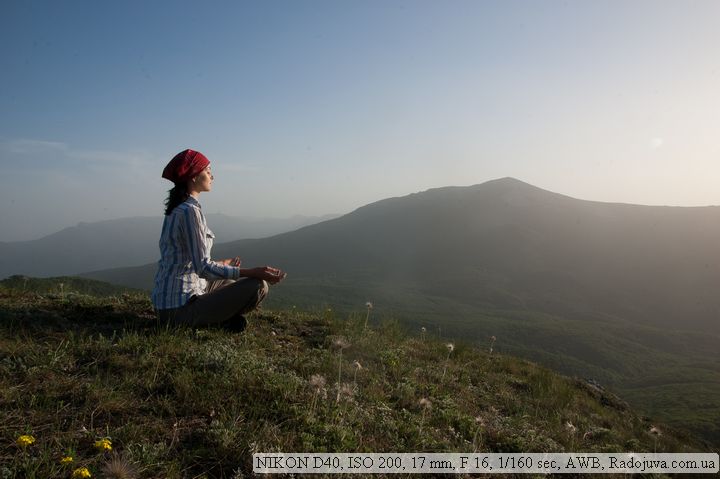
Landscape with man
Conclusions:
Shooting a landscape is not difficult, it is difficult to find a good location. In a landscape, the most important thing is the harmony of combinations of lines, shapes, light and shadow. To correctly compose (select) a picture, you just need to go and experiment. In practice, experience comes very quickly.
Do not forget to press the buttons ↓↓↓ social networks ↓↓↓ - it is important for site. Thanks for attention. Arkady Shapoval.


Good!
Another pleased with a useful article. Comments under the photos are very useful. Composition steers !!!
Thank you for the article! Just in time for the summer season is very welcome! To the above, I can add that strongly closed diaphragms (F22-F36) are undesirable not only because of the dust on the matrix (if you think that you do not have it, then you looked inattentively), but also because of the diffraction of light. At the same time, the contrast of the image and the sharpness are greatly reduced. From my own experience I can say that F5,6-F11 is enough for the landscape. In this range, lenses, including whale ones, are as sharp as possible. Cool results are obtained using polarizers and gradients. Yes, and more! In the Nikon D3100, the grid is ONLY in Live View, it is not in the viewfinder, but in the D3000 it was. (((
About the diaphragm obsalyutno to the point of super focal has not yet been canceled, it will give a good frame for the diaphragm
Yes, in the viewfinder there is no grid in the D5100, it is only in love view, and even then in only one version.
A very good and useful article, I would very much like to see an article about shooting panoramas
Very good (as always) guide. If I am not mistaken, photos were taken in Crimea in Yalta and on Dimerji?
South Dimerji, Alushta.
South Demerdzhi. The name of the mountain is feminine, through "e" ...
Please write how to photograph the technique for reviews (phones, tablets, laptops, etc.)
All this is certainly good, but you forgot to mention one most important thing, that it is undesirable to shoot “Landscape” during the day, something that you do more than once!
You can wait weeks for a suitable time for shooting, not once, I did not take a good landscape the first time.
I mentioned in the paragraph “watch the sun”. More than half of the examples were done in the morning or in the evening, pay attention to this.
Thank you for the article!
Not all Nikons have a grid, for example, the D40 is deprived of it :(
Thanks again!
I draw a lot of instructive from your work.
Little water and a lot of practical information.
I drew attention to your words:
- “I will try to write about different filters (gradient, polarizing, light filter) a little later.”
I would very much like to read and see everything related to the “work” of color balancing and other filters.
Thank you.
Be sure to try to write.
I draw a lot of instructive from your work.
Little water and a lot of practical information.
Very interesting article. Thanks.
Excellent article!
Could you tell me not a bad landscape lens for Canon is not more expensive than 300 ye?
Given that manual focus is not critical for landscapes, I recommend Samyang 14mm f / 2.8 IF ED UMC (it is slightly more expensive than 300 cu)
good advice !!!
-------
http://photo-wed.blogspot.com/
great article)
read more about landscape photography here - http://kak-fotografirovat.com/kak-fotografirovat/kak-fotografirovat-pejzazh.html
You have more advertising than useful information on your site :)
Who is this? Landscape master? Guru? -)
Pictures are inferior. Such illustrations can only be averted from landscape photography.
It would not be bad to see a similar article with a sufficient set of images for examples without processing.
Yuri, if you carefully read the article, you read that the author rarely takes pictures of the landscape. And so pouring dirt on someone’s robot is low. Show your article with the best examples, I think everyone will be happy to read it.
Thanks Arkady for your robot, I found a lot of interesting things.
It's my pleasure. I searched, there are no articles with examples without processing.
Arkady, great article! Thanks. Truth gaze shooting in an accessible way.
Not at all, do not forget about helping the project.
Thanks so much for the article. As always, reading is a pleasure. And along the way, many thanks for the whole site. I did not meet the same in usefulness and ability to present material. Based on your materials, I bought myself a DSLR and, I think, I will continue to use your knowledge and experience for a long time. Good luck with everything.
please tell me the landscape lens for the d5000, preferably up to 5k hryvnia, thanks
For example Tokina 12-24 https://radojuva.com.ua/2012/04/obzor-tokina-at-x-124-pro-dx-ii-12-24-f4/
Excellent article!
Why Radozhiva ???
Why Bui-com?
Because this is the coolest buoy public!
Ok Radozhiva, it’s your time to answer: D
It is joyful - because it is a rainbow life, life in photography in RGB colors.
Mmm ...
Cute and sharp to the point!
please tell me which of the lenses will be more suitable for landscape photography
Nikon 18-200mm f3.5-5.6g af-s dx ed vr II
Nikon 16-85mm f / 3.5-5.6gr
For landscapes, because of a slightly wider angle, 16-85 will be better, also optically 16-85 is one of the best for crop. But for landscapes, it's better to use fixed lenses.
Thank you for the article. Grid complement, the best option is 9, grid lines passing along the * golden ratio *. As in the example with the person in the frame - the horizon along the horizontal line and the person along the vertical, and the frame will turn out to be balanced.
Nikon doesn’t like that they have 4 on 4 lines.
Tell me, please, on the Nikon D5100, displaying the grid is possible only in Live view and dividing the picture by only a quarter?
According to the grid, if it is not there or the 4x4 option can be scratched on the protective film on the screen, actually I did.
Great idea.
And better on the matrix))))
Arkady, the other day I acquired Nikon D3100 and as a beginner, a lot is not clear. Could you give me some simple rules for setting up available? Thank you.
Yes, I can, here - https://radojuva.com.ua/2012/01/hitrosti-na-nikon/
Arkady, hello. Suggest a good lens for landscape photography (only not Nikon - they are very expensive). Maybe from Sigma or Tamron or others. There is Nikon D90 + 18-105 + 50mm f / 1.8d. Or are these enough?
Usually they take a wide-angle lens for the landscape, I recommend https://radojuva.com.ua/2012/04/obzor-tokina-at-x-124-pro-dx-ii-12-24-f4/ but for starters your two are enough.
Thank you, you helped me !!